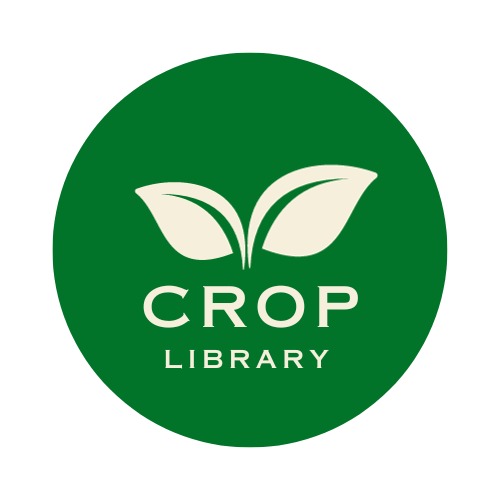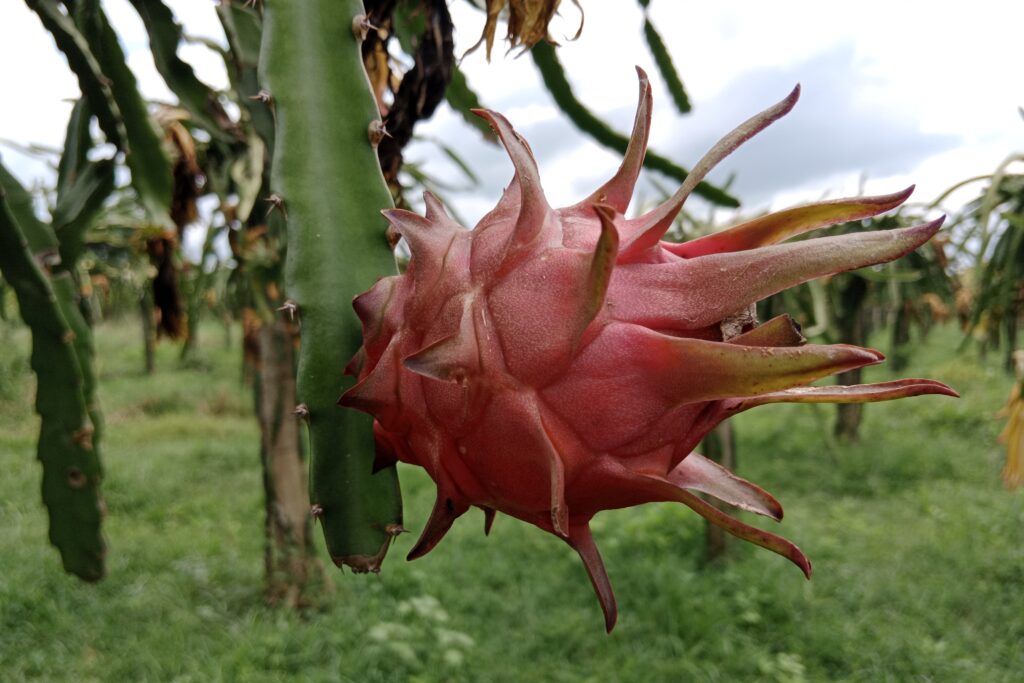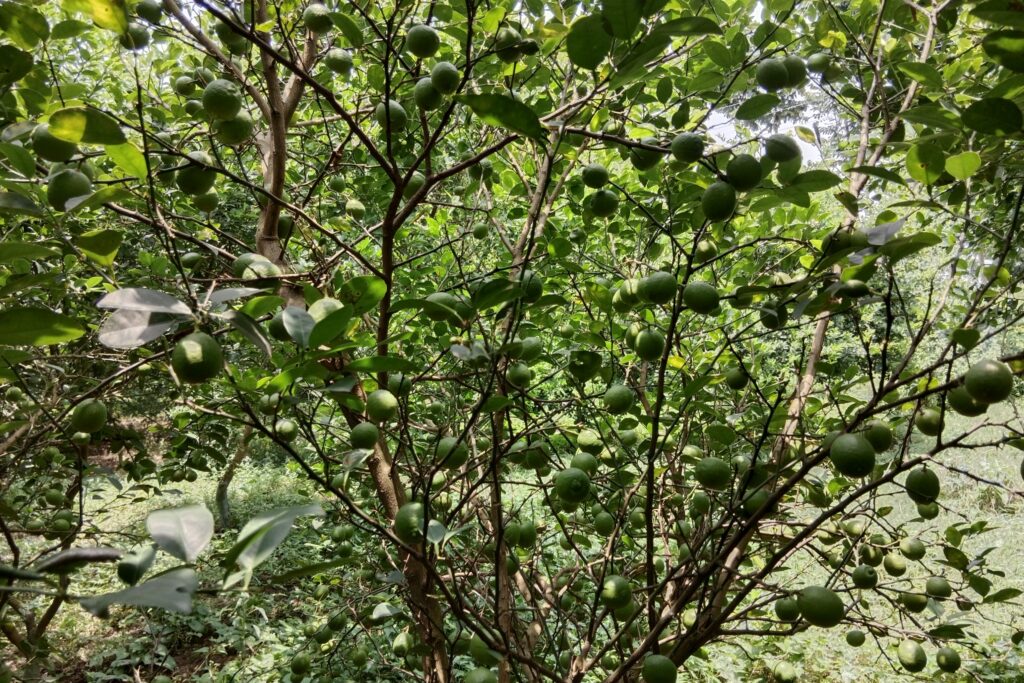Vermicompost Farming
Vermicompost farming profit has emerged as a highly lucrative and sustainable venture within the agricultural sector, offering both economic and environmental benefits. An assessment of a 10-pit vermicomposting system—each pit measuring 10 feet in length, 3 feet in width, and 2 feet in depth—shows that a startup cost of roughly NPR 232,980 is required.
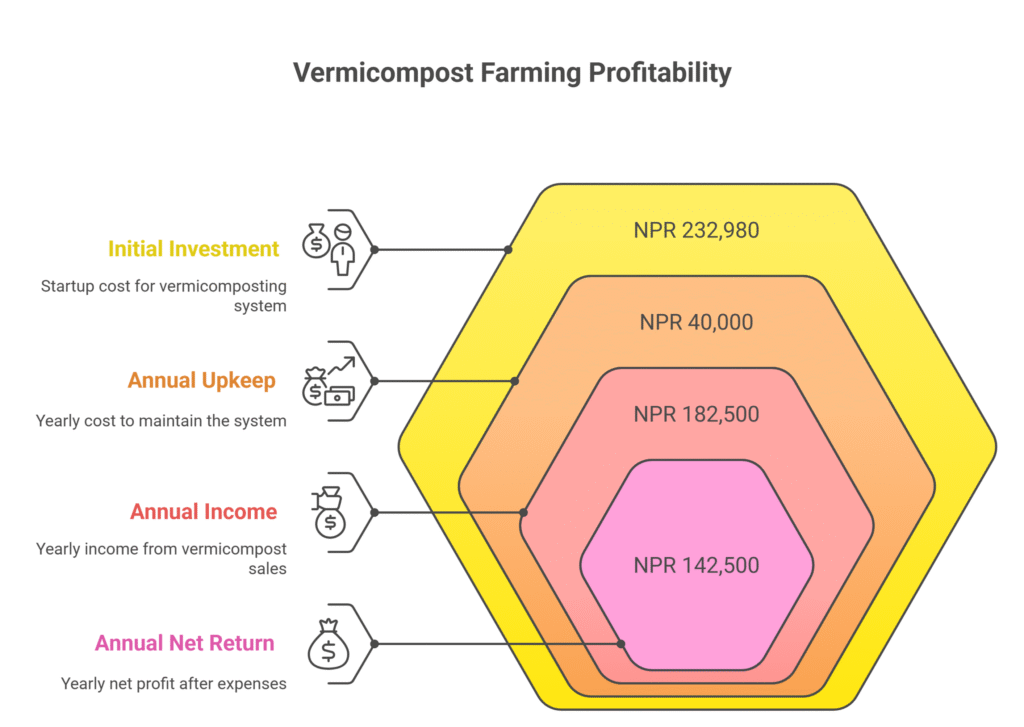
This amount typically includes expenses for pit construction, raw inputs such as cow dung and earthworms, labor, and necessary tools. The annual upkeep is estimated at about NPR 40,000, making the business highly affordable in the long term. On average, around 4,000 kilograms of vermicompost and 275 kilograms of excess worms can be sold each year, bringing in an income of approximately NPR 182,500.
The initial investment is usually recovered within two years, after which the profit margin steadily increases. Consequently, the business can generate a consistent annual net return of nearly NPR 142,500, positioning vermicompost farming as both a dependable income source and a sustainable agricultural opportunity.
What is Vermicomposting?
Vermicomposting is an environmentally friendly and sustainable method of managing organic waste. It employs specific species of earthworms to biologically degrade organic residues and convert them into a nutrient-rich material known as vermicompost or worm castings. The final product is dark, granular, and has an earthy aroma, making it a highly effective organic fertilizer for improving soil quality and plant growth.
This process involves more than simple decomposition. It represents a biological oxidation and stabilization mechanism in which earthworms, along with beneficial microorganisms, transform organic matter into a stable, humus-like substance that plants can easily absorb. Through this combined action, the waste material becomes enriched with essential nutrients, thereby supporting sustainable soil management practices.
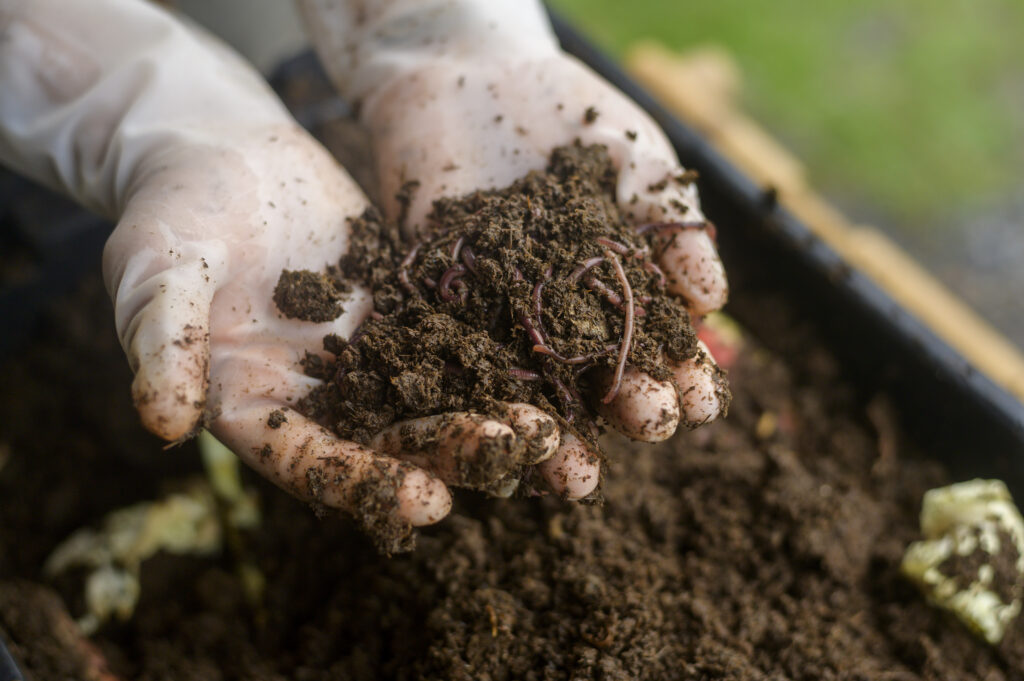
Vermicompost functions as both a natural fertilizer and a soil conditioner. It improves soil structure, enhances nutrient and moisture retention, and promotes vigorous plant development. Due to its high nutrient content and ecological benefits, it is often referred to by organic farmers as “black gold.”
Unlike traditional composting, which depends on heat-generating microbes and requires high temperatures, vermicomposting operates efficiently under moderate thermal conditions. This makes the process faster, more energy-efficient, and adaptable for both small household setups and large-scale agricultural or waste management applications.
Earthworms serve as the key biological agents in this system. They consume organic waste, fragment and digest it, and, in cooperation with microorganisms in their gut, produce fine, nutrient-dense castings. These castings enhance soil fertility, stimulate microbial activity, and contribute to sustainable and environmentally responsible crop production.
Composition of Vermicompost
Vermicompost is a nutrient-rich organic fertilizer valued for its balanced and beneficial composition, which contributes significantly to soil fertility and plant productivity. It typically contains about 25–30% moisture and approximately 22% organic matter, creating an optimal environment for beneficial soil microorganisms and root activity.
The fertilizer also provides a well-balanced blend of primary macronutrients essential for plant growth—approximately 1.6% Nitrogen (N), which supports vigorous vegetative growth; 0.6% Phosphorus (P), which enhances root development and flowering; and 0.8% Potassium (K), which improves overall plant health, resilience, and disease resistance. This nutrient composition makes vermicompost an excellent natural soil amendment for both organic and conventional farming systems, contributing to sustainable agricultural practices and long-term soil health
Why Practice Vermicomposting?
The advantages of vermicomposting extend across environmental, agricultural, and economic dimensions, making it an effective strategy for sustainable waste management and soil enhancement.
a) Waste Reduction
Vermicomposting transforms a large share of household and agricultural organic waste—often around one-third—into valuable compost instead of allowing it to accumulate in landfills. By minimizing organic waste disposal, this process curbs methane emissions and contributes to a cleaner, more sustainable environment.
b) Production of High-Quality Organic Fertilizer
The compost produced through vermiculture is a nutrient-rich material containing readily available forms of nitrogen, phosphorus, potassium, and trace minerals essential for plant growth. It enhances soil quality by improving aeration, water-holding capacity, and drainage. Additionally, vermicompost introduces beneficial microorganisms that suppress soil-borne pathogens and foster healthier root systems, thereby promoting stronger crop growth.
c) Source of Supplemental Income
Beyond its environmental value, vermicomposting can serve as an income-generating activity. Farmers and gardeners can sell surplus compost or breeding worms to other growers, nurseries, or organic farming operations.
d) Low-Cost and Sustainable
The process requires only modest investment, relying primarily on biodegradable waste materials and simple equipment. This makes it both accessible and sustainable, forming a closed-loop system that recycles organic residues back into productive use.
e) Reduction in Chemical Fertilizer Dependence
By improving soil fertility through natural means, vermicomposting lessens reliance on chemical fertilizers. Over time, this reduces production costs and mitigates the environmental impact associated with synthetic inputs.
Suitable Earthworms for Vermicomposting
The most effective earthworms for vermicomposting are epigeic species—those that inhabit the upper layers of soil and organic litter. These worms consume large amounts of decaying matter, reproduce rapidly, and adapt well to confined composting environments.
a) Eisenia fetida (Red Wiggler / Tiger Worm)
Among the most popular species used in vermicomposting, Eisenia fetida is easily recognized by its reddish body marked with pale yellow bands. It thrives in a range of composting conditions, efficiently breaking down organic waste while reproducing at a high rate. Its resilience to temperature fluctuations makes it suitable for both small-scale household composting and larger commercial operations.
b) Eudrilus eugeniae (African Nightcrawler)
This species is comparatively larger and grows faster than Eisenia fetida. Eudrilus eugeniae breeds rapidly, allowing for quick population increases in active composting systems. However, it prefers warm, moist environments and tends to underperform in cooler climates, making it best suited for tropical or subtropical regions.
c) Perionyx excavatus (Indian Blue Worm)
Native to tropical and subtropical areas of Asia, Perionyx excavatus efficiently converts organic materials into compost in a relatively short period. Although highly productive, this species is sensitive to environmental changes and may leave the composting bed when temperature or moisture levels become unfavorable, so consistent monitoring is essential.
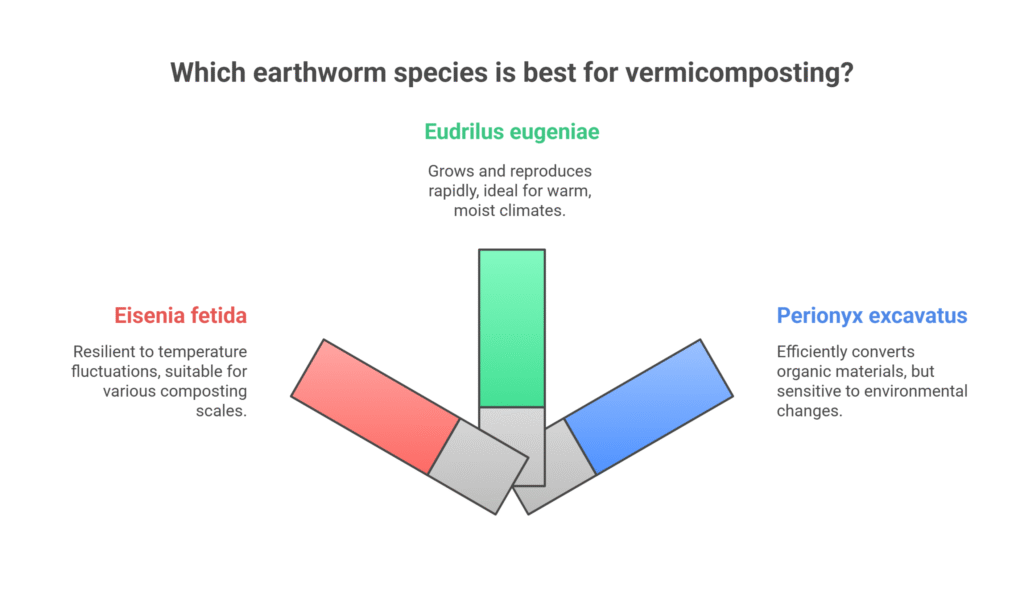
Favorable Conditions for Earthworm Vermicomposting
For vermicomposting to operate efficiently, earthworms must live in an environment that supports their biological activity and comfort. Proper management of feed, moisture, temperature, aeration, and pH ensures optimal decomposition and worm productivity.
A balanced diet is essential. The feeding material should combine nitrogen-rich “green” wastes—such as vegetable and fruit residues, grass clippings, and kitchen scraps—with carbon-rich “brown” matter like dry leaves, shredded cardboard, or straw. This mix maintains appropriate nutrient and carbon-to-nitrogen ratios that sustain both worms and microbial decomposers.
Moisture content is another critical factor. The bedding should be kept damp but not waterlogged—roughly equivalent in feel to a wrung-out sponge—with a moisture level around 60–70%. Insufficient moisture can dry out or stress the worms, while excessive water reduces oxygen levels and encourages anaerobic conditions.
Temperatures also strongly influence worm activity. The ideal range for most composting species lies between 15°C and 25°C (59°F–77°F). Extreme cold, direct sunlight, or excessive heat should be avoided to prevent mortality or slowed reproduction.
Adequate air exchange keeps the system aerobic. Bedding should be loose and well-fluffed to allow airflow, and light stirring can prevent compaction. Maintaining a pH close to neutral (6.5–7.5) supports worm health and microbial balance. Acidic or alkaline materials—such as citrus peels, onions, or highly processed food waste—should be added sparingly to preserve a stable composting environment.
Materials Required for Vermicomposting
Effective vermicomposting begins with the use of biodegradable inputs such as kitchen leftovers, crop residues, and partially decomposed animal manure—commonly from cows, horses, or goats. These organic materials act as the primary nutrient supply for both microorganisms and earthworms. Typically, about one kilogram of worms is introduced per square meter of composting surface to start and accelerate the decomposition process.
A suitable bedding layer should be created to provide comfort and aeration for the worms. Dry fibrous materials—like chopped straw, shredded paper, dried leaves, cardboard pieces, or cocopeat—serve as excellent substrates due to their high carbon content and porosity. The bedding must remain moist but not waterlogged; regular sprinkling of water helps maintain this balance.
To protect the system from environmental extremes, the composting area should be placed under natural shade or covered with materials such as gunny sacks or mesh fabric. This shields the worms from direct sunlight and heavy rain while maintaining moderate humidity.
Depending on available space and resources, the vermicomposting setup may be established in a cement tank, a shallow pit, or as a raised heap directly on the ground.
Methods of Vermicompost Farming
Vermicomposting can be practiced through several approaches, with the bed method and pit method being the most widely adopted because of their ease of management and efficiency. Both techniques aim to create favorable conditions for earthworms while facilitating the controlled decomposition of organic matter.
Bed Method
In this approach, composting is carried out above ground by forming raised layers of organic material. The method is economical, simple to manage, and well-suited for farmers with limited space. Beds are typically constructed on a cemented or earthen surface and measure approximately 6 feet long, 2 feet wide, and 2 feet high, although dimensions may vary according to available area.
The organic substrate usually includes materials such as crop residues, cow dung, and other biodegradable wastes arranged in layers. This system allows for good aeration and easy handling during watering, turning, and harvesting. Because of its low setup cost and convenience, the bed method is effective for both household-level and commercial-scale vermicomposting operations.
Pit Method
This method offers better protection for the worms and is good for areas with scarcity or extreme weather.
a). Pit Construction
Dig a pit about 2 feet deep, 3 feet wide, and 10 feet of a convenient length. The bottom and sides can be plastered with mud or cement to prevent waterlogging and predator entry.
b). Base Layer
Add a 4–6-inch layer of broken bricks or gravel at the bottom for drainage.
c). Bedding and Waste
Add a 6-inch layer of sandy soil. Then, add a 1-foot layer of organic waste mixed with cow dung. Moisten the layer.
d). Release the Worms
Introduce the earthworms onto the bed.
e). Layering
Continue adding thin layers of organic waste every week, ensuring the bed does not dry out.
f). Covering
Cover the pit with a thatch roof or gunny bags.
g). Harvesting
After 50-60 days, stop watering. The worms will move downward. After a week, remove the finished compost from the top. The remaining worms can be used for the next cycle.
Cost of Investment in Vermicompost Farming through Pit Method
The total estimated investment for constructing 10 vermicompost pits, each measuring 10 ft (L) × 3 ft (W) × 2 ft (D), is NPR 232,980. The breakdown of cost is given in the table below:
| Category | Cost Component | Quantity | Unit | Rate per Unit (NPR) | Total Cost (NPR) |
| Construction | Bricks | 2,500 | Pcs | 20 | 50,000 |
| Cement | 600 | Kg | 20 | 12,000 | |
| Sand | 1200 | kg | 12 | 14,400 | |
| PVC Pipe | 60 | Ft. | 40 | 2,400 | |
| Shade Net | 300 | Sq. ft. | 30 | 9,000 | |
| Raw Materials | Cow Dung | 2,000 | kg | 5 | 10,000 |
| Earthworms | 275 (27.5 kg /pit) | kg | 300 | 82,500 | |
| Tools & Equipment | Watering Can | 2 | Pcs | 1000 | 2,000 |
| Shovel/Spade | 2 | Pcs | 2,000 | 4,000 | |
| Sieve | 4,000 | 4,000 | |||
| Buckets & Misc. | — | — | 1,500 | ||
| Labor | Unskilled Labor | 20 | Individual | 1,000 | 20,000 |
| Sub-Total | 211,800 | ||||
| Contingency (10%) | 21,180 | ||||
| Total Estimated Investment | 232,980 |
Annual Maintenance Cost of Vermicompost Farming
The annual maintenance for the vermicompost pits is estimated at NPR 40,000. This recurring cost covers essential inputs like cow dung, regular labor for upkeep, and miscellaneous expenses for water, tool maintenance, harvesting, and minor repairs.
Income from Vermicompost Farming in 10 Pits
The income from vermicomposting is given below.
| Particular | Annual Quantity / Pit (Kg) | Number of Pit | Total Yield (kg) | Rate /Kg (NRs.) | Annual Income (NRs.) |
| 1. Yield of Vermicompost | 400 | 10 | 4000 | 25 | 100,000 |
| 2. Yield of Surplus Earthworms | 27.5 | 10 | 275 kg | 300 | 82,500 |
| Total Gross Annual Income | 182,500 |
Analysis of Vermicompost Farming Profit
Year-by-Year Financial Analysis up to 25 Years
This table tracks the cash flow over time.
| Year | Initial Investment (NPR) | Annual Income (NPR) | Annual Maintenance Cost (NPR) | Net Annual Cash Flow (NPR) | Cumulative Cash Flow (NPR) |
| Year 0 | (232,980) | – | – | (232,980) | (232,980) |
| Year 1 | – | 182,500 | (40,000) | 142,500 | (90,480) |
| Year 2 | – | 182,500 | (40,000) | 142,500 | 52,020 |
| Year 3 | – | 182,500 | (40,000) | 142,500 | 194,520 |
| Year 4 | – | 182,500 | (40,000) | 142,500 | 337,020 |
| Year 5 | – | 182,500 | (40,000) | 142,500 | 479,520 |
| … | … | … | … | … | … |
| Year 25 | – | 182,500 | (40,000) | 142,500 | 33,29,520 |
References
- Domínguez, J., & Edwards, C. A. (2010). Relationships between composting and vermicomposting: Relative values of the products. In C. A. Edwards, N. Q. Arancon, & R. L. Sherman (Eds.), Vermiculture Technology: Earthworms, Organic Wastes, and Environmental Management (pp. 1–14). CRC Press.
- Edwards, C. A., Arancon, N. Q., & Sherman, R. L. (2011). Vermiculture Technology: Earthworms, Organic Wastes, and Environmental Management. CRC Press.
- FAO (Food and Agriculture Organization of the United Nations). (2017). Vermicomposting for Sustainable Agriculture. FAO Publishing, Rome.
